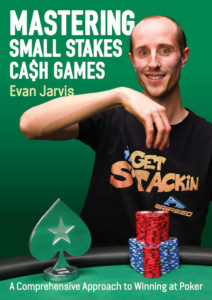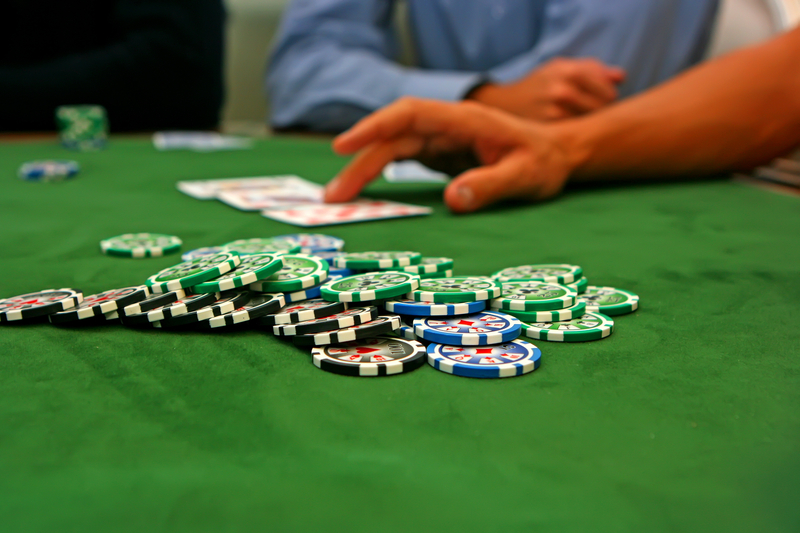Playing the blinds is a critical part of poker and Evan Jarvis offers some tips on that aspect of the game from his new book Mastering Small Stakes Ca$h Games.
Jarvis has more than 10 years of experience playing poker, cash games and tournaments both live and online. He’s worked closely with some of the biggest names in the game such as Greg Merson, Griffin Benger, Charlie Carrel, and Ali Imsirovic.
His career has ranged from playing micro stakes to high stakes, and he has more than $1 million in live and online winnings. This chapter from the book focuses on maximizing play from the blinds.
Blind considerations
In the vast majority of No Limit Hold’em cash games, you’ll be required to post a blind twice during every orbit. On one of those occasions, you’ll be posting the big blind and sitting two seats to the left of the dealer. The hand after that, you’ll be posting the small blind, with the dealer on your immediate right.
Almost all the considerations we’ve talked about elsewhere in this book apply when you’re in the blinds. But it’s worth taking a particular look at preflop play from these seats as there are a few additional considerations.
when you’re in the blinds. But it’s worth taking a particular look at preflop play from these seats as there are a few additional considerations.
Most notably, when you’re in the blinds you make your decisions last preflop, but first post-flop. It means you get the most information from your opponents in the preflop betting round, but the least for every round after that. We’ll look at how this can affect your decision-making process.
Playing the blinds will also often give you your first introduction to odds in poker and understanding odds is what leads to long-term profit in the game. It follows that understanding how to play the blinds is critical to your poker success.
But I also want to stress that making preflop decisions from the blinds based solely on equity calculations can be a mistake.
You are usually better off remembering the significant positional disadvantage you will be in post-flop, as well as the fact that there is much, much more betting to be done after the flop than there is preflop.
It should help you to think twice about getting involved preflop with junky hands, just because the pot odds are so good.
The equity myth
Normally – i.e., if you’re not in the blinds – when you’re faced with an open raise of three times the big blind (3x), you are getting odds of 3:4.5 on a call.
This means that the reward for calling and winning the hand is 4.5 units total, comprising 3 (their raise) + 1 big blind + 0.5 small blind.
Your risk is 3 units, i.e., you’re putting in 3 to play for another 4.5 or, in other words, a total pot of 7.5. The odds are 3:4.5
With odds like these, if all other factors were equal, we could expect to win the pot at least 40% of the time and turn a profit. You’d be breaking even on your initial investment because 3 divided by 7.5 is 0.4 or 40%.
That means if you manage to win the pot more than 40% of the time, you turn a profit on your investment. If you anticipate winning less than 40%, then you’re losing money on your call every investment.
However, it’s worth noting that preflop betting represents only one section of a full poker hand. We also have betting on flop, turn, and river.
So if you can find a positive expectation on the higher stakes post-flop play, you can get away with playing hands that have slightly less than break-even equity preflop.
Wow! I've been dreaming about this for almost 10 years…
Thanks to @DBPoker1 and @JonathanLittle I am officially a PUBLISHED AUTHOR!
Mastering small stakes cash games condensed all of my best teachings and years of poker experience into 360 pages
And I can't wait to share it! pic.twitter.com/RkTbhmV8qg
— 🐺 Evan Jarvis 🐺 (@Gripsed) January 18, 2022
Equity versus win frequency
Let’s revisit a subject from the last chapter: the part where we looked at a player in the big blind’s win frequency against an open raise.
Consider when you’re in the big blind. It will demonstrate why it’s the wrong approach to look only at the price you’re getting when playing from the blinds.
When you’re facing a 3x raise, the odds are:
- Reward: 3 (their raise) + 1 big blind + 0.5 small blind = 4.5
- Risk: 2 (you’ve already posted 1 and it’s 2 more to see the flop)
- Odds: 2:4.5
- Win frequency needed: 2/6.5 (2 + 4.5) = 30.77%
Note: we use “win frequency” instead of “equity” as we don’t expect betting to be done for the hand, so equity isn’t the right term.
Our win frequency needed is roughly 31%. That’s a pretty low number, right – especially when you remember that any two live cards have equity of around 33% against A-K.
What about when you’re facing a min-raise – i.e., 2x?
- Reward: 2 (their raise) + 1BB + 0.5 BB = 3.5
- Risk: 1
- Odds: 1:3.5
- Win frequency needed: 1/4.5 = 22.22%
In this situation, even 3-2(suited) seems playable. That hand has almost 20% equity against A-A! It seems that when you’re facing small raise sizes while in the big blind, you don’t need to win often to justify continuing with the hand. It seems that the “price is right.”
The post-flop situation
However – and this is important – for this to be true you still need to be breaking even on all bets post-flop. And even if you are a very skilled post-flop player, you are at a significant positional disadvantage on every subsequent betting round.
If, overall, you’re making money from your opponents by playing better post-flop, then when they min-raise, you should defend your blind with the entire deck.
But if you’re playing against a very strong opponent and you have great preflop odds, there’s nothing wrong with sticking to the same range as you think they are opening, or even a tighter range of hands.
This way, you have an equity advantage based on your cards, and you won’t be getting yourself into tricky post-flop situations.

Hand selection and equity
In my experience, the most important thing to focus on when in the blinds is playing the right types of hands. Outplaying your opponent from out of position is challenging against solid players.
The types of hands you want to play are:
- Hands that are ahead of your opponent’s opening range.
- Suited Aces and suited face cards, which will cooler a wide opening range of all suited hands.
- Small connectors as they’re unlikely to be dominated when making two pair and can make hidden straights.
Hands to avoid: middling off-suit hands. They usually only make middle or top pair, marginal kicker. Likewise, if a hand makes two pair, it’s often dominated by a better two pair or trips.
Posting a big blind doesn’t mean you have to defend it
Just because you posted the big blind doesn’t mean you have to defend it. Posting the blinds is just part of the game. Everyone does it, and once the money is in the pot it no longer belongs to you.
I repeat, once the money crosses the betting line, it belongs to the pot (aka nobody) and does not belong to you unless you win the pot.
There is no need to “defend” money that isn’t yours. Doing so will only invite trouble. There should be no emotional component.
Otherwise, you’re just doing what the long-term losing gamblers do: chasing losses and throwing good money after bad to get even.
Since you’re reading this book, you’re not a losing gambler; you’re a profitable investor who knows when the price is right or when the odds are in your favor. And when the odds are against you, you do the smart thing and FOLD.
